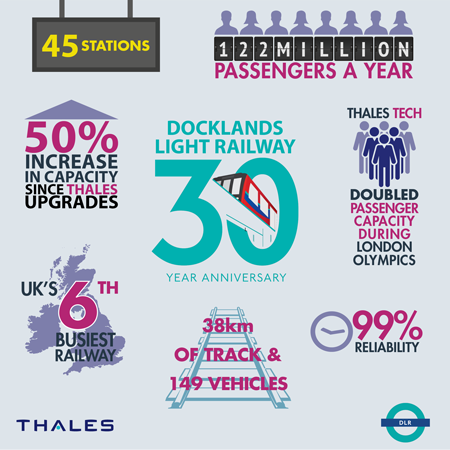Behind the scenes… at East London’s transformative railway

Tell us a little bit about yourself
I’m Chris Fairman, a Project Manager at Thales working on London’s Docklands Light Railway (DLR) Signalling System. I’ve been working with DLR since 2009 and I’m responsible for the Thales contracts to deliver signalling upgrades and performance enhancements to the DLR network. I make sure the work we do is on time and on budget!
From your experience, how has Thales’s involvement in the DLR changed over the years?
Thales (then Alcatel) re-signalled the DLR network in 1994 and it was since this date that the DLR has been an attendant-only operation. Since then we have seen the DLR network grow with new extensions to Beckton, Lewisham, Woolwich Arsenal and Stratford International. Thales has been a significant part of these projects and other works over the past 23 years and in addition to the project works, we also provide a signalling support service to assist with any trouble-shooting and investigations as well as providing a spares and repairs service to DLR. Ultimately, the Thales team makes sure the right expertise is available to keep the DLR running smoothly.
It’s clearly a pretty huge programme. How have Thales and the DLR teams approached working together?
The relationship between DLR and Thales has grown over the years from contractor-subcontractor, to a more collaborative working philosophy, with Thales staff permanently “embedded” in the DLR team, co-located in the same building. This has enabled our relationship to develop, enabling close cooperation on the project’s technical requirements and deployments, as well as fast and effective responses to customer queries and requests. We have been able to tailor our staff expertise and development to ensure we meet the need of our customer and have established a “one team” approach with DLR such that communication is continual and effective.
Are there any highlights from your time working on the DLR so far?
For me, the absolute highlight was working with the DLR team during the London 2012 Olympics. I think this period was testament to the strength of our relationship and we all felt we contributed to part of the success of the games. The DLR carried a record-breaking number of passengers during the event and our systems managed it seamlessly!
With all the work that has taken place, what benefits do you see the DLR having for London?
Aside from moving a considerable number of people around east and central London, the DLR is a vital element in the Transport for London portfolio. Not least because it serves as a link between the financial districts at Bank and Canary Wharf, it connects with London Underground, Overground and National Rail services, but also because most passengers using London City Airport travel via the DLR. As the UK’s first attendant-only operation, It has played a pivotal role in opening up the east of London for locals and also encourages visitors to the area’s cultural attractions such as Greenwich, the Cutty Sark and of course the ExCeL.
Finally, how do you see transport systems developing in London over the coming years?
I think that the push to modernise transport systems to be more efficient and, therefore, move more people in comfort is the main factor in the next few years. Faster, more comfortable, air-conditioned trains (and buses), with 4G mobile – as well as a safe, clean and modern environment both on-board and in station areas, will be essential. With the DLR as well as our upgrades to the Jubilee and Northern Lines and the on-going 4LM project, we’re on our way to achieving this vision for London.
